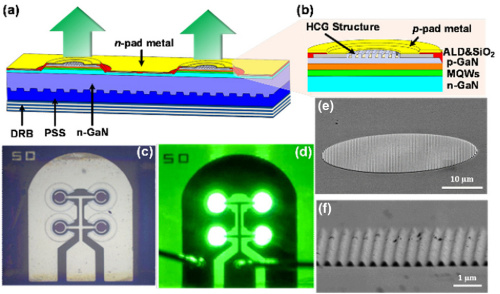Gong-Ru Lin, Hao-Chung Kuo, Chih-Hsien Cheng, Yi-Chien Wu, Yu-Ming Huang, Fang-Jyun Liou, and Yi-Che Lee
Photon. Res. 9, 2077-2087 (2021) — Published in September 2021
ABSTRACT
A green 2×2 micro light-emitting diode (μ-LED) array with nanostructured grating patterns grown on a semipolar (20-21)-oriented gallium nitride (GaN) buffered layer on (22-43)-oriented sapphire substrate is specially transistor-outline can (TO-can) packaged with a sub-miniature-A (SMA) connector for high-speed data communication beyond 5 Gbit/s. Through a specific design for suppressing the quantum-confined Stark effect (QCSE) in the green 2×2 μ-LED array with a low polarization-related electric field and flat quantum well band diagram, the green 2×2 μ-LED array exhibits a turn-on voltage of 2.5 V and output power of 0.3 mW at 1 A/cm2. The green 2×2 μ-LED array also reveals a wavelength shift from 543 nm to 537 nm smaller than that of conventional devices grown on c-plane buffered GaN substrate due to the inhibited QCSE. The 50 µm emission aperture of the green 2×2 μ-LED array ensures a lower capacitance for a larger −3 dB modulation bandwidth, which exhibits −1 dB power compression at a larger bias under high-speed operation, as it is less affected by the high resistance of the single μ-LED element. With a specific TO-can+SMA package, the green 2×2 μ-LED array exhibits maximal data rates exceeding 1.5 Gbit/s for the non-return-to-zero on–off keying format and beyond 5.02 Gbit/s for the bit-loaded discrete multitone (BL-DMT) format, which is very promising for optical wireless communication. As the sampling rate increases from 4 GSa/s to 16 GSa/s, the μ-LED array’s received signal-to-noise ratio (SNR) improves dramatically from 15.4 dB to 12.2 dB. The SNR remains about 15.4 dB, with a matching bit-error ratio (BER) of 2.7×10−3, whereas the 10-fold oversampling of the eight-ray quadrature amplitude modulation orthogonal frequency-division multiplexing (8-QAM OFDM) data stream with 16 GSa/s appears to reduce the SNR by −3 dB, resulting in a decoded BER of 3.3×10−3. The green 2×2 μ-LED array has demonstrated greater potential in data transmission beyond 5 Gbit/s using the BL-DMT algorithm for future applications in domains of visible light communication or optical wireless communication when packaged with handed mobile devices.

